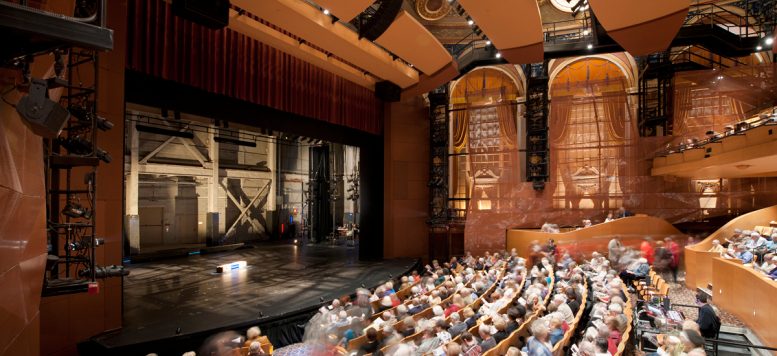By DAVID DUPONT
BG Independent News
When Mary Ellen Mazey was president of Bowling Green State University, she called the arts the front porch of the university. Last week during the Ohio Town and Gown Summit, architect Patrick Hyland, of DLR Group, used a different expression: The arts were the “town-gown zipper.”
Hyland discussed four Ohio projects that exemplified the idea that arts facilities can bring schools and communities closer together.
At Mount Union College in Alliance, the 1950s vintage arts center was on the edge of campus. The building had “bomb shelter” qualities, and college officials wanted something more attractive and functional.
Also, the school realized it was lagging in female enrollment. Part of the problem, Hyland said, was the poor state of the arts facilities. A new venue was needed not necessarily for majors, but for students who wanted to continue to be involved in theater and music even while pursuing other degrees.
The Giese Center was packaged with raising money for health science facilities.
The Giese Center included a large, multi-use facility that could be used for music, theater, receptions, and lectures. It was large enough to bring in touring road shows and was available to the local public school.
The facility also included a black box theater, a flexible space akin to BGSU’s Eva Marie Saint Theatre.
The Apollo Theater in downtown Oberlin near the Oberlin College was also badly in need of repair.
The movie house built in 1913 had undergone “various bad renovations” over the years, Hyland said. Its days as a first-run theater were over. The college was investing in creating an arts district neighboring its conservatory.
The theater was turned into the home of Oberlin’s film program. The historic character of the old theater was maintained. Historic preservation tax credits were used to fund part of the project.
The main auditorium was reduced from 800 seats to 500. Another smaller 60-seat screening room for student projects, both by college and high school students, was carved out within the space.
The Allen Theater on Euclid Avenue in Cleveland also opened as a movie house, albeit on a much grandeur scale, seating more than 3,000. By the 1970s it and its neighboring theaters were in disrepair and were slated to be torn down and turned into parking lots, Hyland said.
But civic and arts groups banded together to oppose the move. “What magnificent buildings they are,” Hyland said. “We saved them.”
The Allen was the last of the buildings in Cleveland’s Playhouse Square to open.
The architect noted that Playhouse Square is the second largest performing arts venue in the country, trailing only Lincoln Center in New York City. . Art Falco, president and CEO of the Playhouse Square Foundation who joined the effort in 1985, is a BGSU graduate.
When it reopened in 1993, the Allen hosted touring Broadway productions, but about a decade later, those touring shows had shifted to another venue, leaving it unused. The Cleveland Play House, the city’s Tony-Award-winning professional company, needed a new home. Cleveland State, which is located near Playhouse Square, wanted to upgrade its theater facilities. The result was a project that transformed the 81,000-square-foot theater into three theater spaces and a large lounge area.
The main house seats 512 people, while a flexible theater that can be set up as in the round or thrust stage seats 300. There is also a small 200-seat black box theater.
“We right-sized it,” Hyland said. Still the essential historic character of the venue was maintained.
Not only do Cleveland State students have performance spaces, but with a professional theater operating adjacent to campus they have opportunities for work that will earn them credits toward earning their craft union cards.
The last project Hyland discussed was the McCoy Center for the Arts in New Albany. This did not involve a college, but rather the school district. Here the community and school district pooled resources to provide the city with a state of the art performing arts venue that serves not only the needs of the district’s students, but attracts top national acts and speakers. The new venue even inspired the creation of a community orchestra.
The center uses classic Jeffersonian architecture, and opens up onto the center of town.
These were success stories, Hyland said. They are made possible, he said, by the close collaboration of all those with a stake in the projects. Towns and colleges, he said, can join forces on these projects and build performing arts centers that neither alone could finance.


